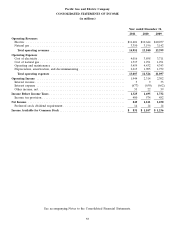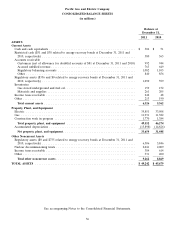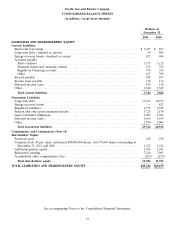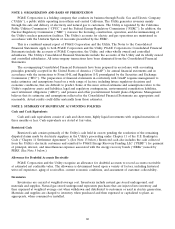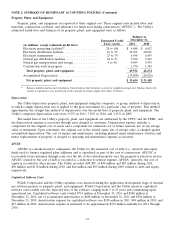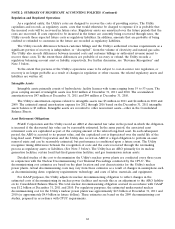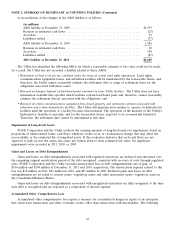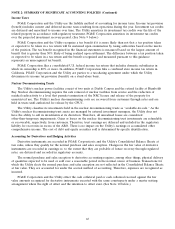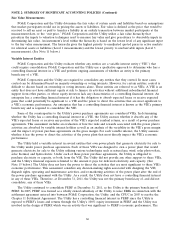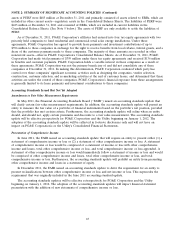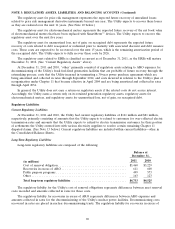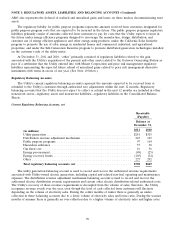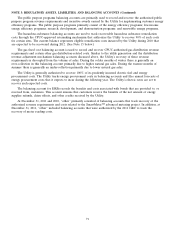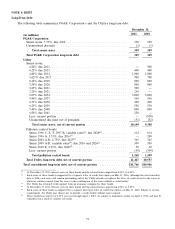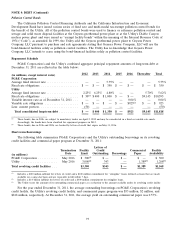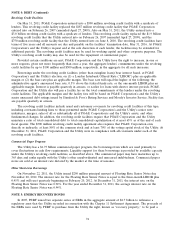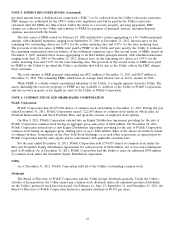PG&E 2011 Annual Report Download - page 69
Download and view the complete annual report
Please find page 69 of the 2011 PG&E annual report below. You can navigate through the pages in the report by either clicking on the pages listed below, or by using the keyword search tool below to find specific information within the annual report.NOTE 2: SUMMARY OF SIGNIFICANT ACCOUNTING POLICIES (Continued)
Income Taxes
PG&E Corporation and the Utility use the liability method of accounting for income taxes. Income tax provision
(benefit) includes current and deferred income taxes resulting from operations during the year. Investment tax credits
are deferred and amortized to income over time. The Utility amortizes its investment tax credits over the life of the
related property in accordance with regulatory treatment. PG&E Corporation amortizes its investment tax credits
over the projected investment recovery period. (See Note 9 below.)
PG&E Corporation and the Utility recognize a tax benefit if it is more likely than not that a tax position taken
or expected to be taken in a tax return will be sustained upon examination by taxing authorities based on the merits
of the position. The tax benefit recognized in the financial statements is measured based on the largest amount of
benefit that is greater than 50% likely of being realized upon settlement. The difference between a tax position taken
or expected to be taken in a tax return and the benefit recognized and measured pursuant to this guidance
represents an unrecognized tax benefit.
PG&E Corporation files a consolidated U.S. federal income tax return that includes domestic subsidiaries in
which its ownership is 80% or more. In addition, PG&E Corporation files a combined state income tax return in
California. PG&E Corporation and the Utility are parties to a tax-sharing agreement under which the Utility
determines its income tax provision (benefit) on a stand-alone basis.
Nuclear Decommissioning Trusts
The Utility’s nuclear power facilities consist of two units at Diablo Canyon and the retired facility at Humboldt
Bay. Nuclear decommissioning requires the safe removal of nuclear facilities from service and the reduction of
residual radioactivity to a level that permits termination of the NRC license and release of the property for
unrestricted use. The Utility’s nuclear decommissioning costs are recovered from customers through rates and are
held in trusts until authorized for release by the CPUC.
The Utility classifies its investments held in the nuclear decommissioning trusts as ‘‘available-for-sale.’’ As the
Utility’s nuclear decommissioning trust assets are managed by external investment managers, the Utility does not
have the ability to sell its investments at its discretion. Therefore, all unrealized losses are considered
other-than-temporary impairments. Gains or losses on the nuclear decommissioning trust investments are refundable
or recoverable, respectively, from customers. Therefore, trust earnings are deferred and included in the regulatory
liability for recoveries in excess of the ARO. There is no impact on the Utility’s earnings or accumulated other
comprehensive income. The cost of debt and equity securities sold is determined by specific identification.
Accounting for Derivatives and Hedging Activities
Derivative instruments are recorded in PG&E Corporation’s and the Utility’s Consolidated Balance Sheets at
fair value, unless they qualify for the normal purchase and sales exception. Changes in the fair value of derivative
instruments are recorded in earnings or, to the extent that they are probable of future recovery through regulated
rates, are deferred and recorded in regulatory accounts.
The normal purchase and sales exception to derivative accounting requires, among other things, physical delivery
of quantities expected to be used or sold over a reasonable period in the normal course of business. Transactions for
which the Utility elects the normal purchase and sales exception are not reflected in the Consolidated Balance Sheets
at fair value. They are accounted for under the accrual method of accounting. Therefore, expenses are recognized as
incurred.
PG&E Corporation and the Utility offset the cash collateral paid or cash collateral received against the fair
value amounts recognized for derivative instruments executed with the same counterparty under a master netting
arrangement where the right of offset and the intention to offset exist. (See Note 10 below.)
65


